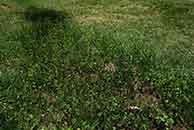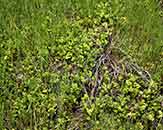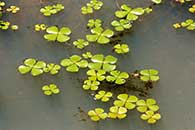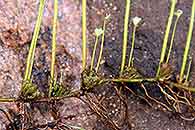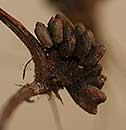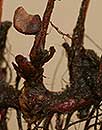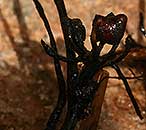Marsilea ephippiocarpa Alston
Synonyms |
|
|---|---|
Common name |
|
Description |
Floating form: stipe up to 30 cm long, hairless; leaflets broadly obovate, outer margin entire to irregular, hairless, under surface often with thin dark streaks. Dry land form: fronds clustered, stipe up to c. 15 cm long, leaflets outer margins irregularly incised or wavy, hairless. Sporocarps: in compact clusters of 3-10 at the nodes, dark brown, 2-3.5 mm long, 2-4 mm high, 0.5-1.5 mm thick, saddle-shaped, upper side deeply concave, lower side rounded, lateral surfaces concave, oblong-elliptic in vertical cross-section; hairless when mature; lateral ribs not visible in mature specimens; lower tooth absent, upper tooth present, acute; pedicels adnate, a peduncle-like base branching dichotomously, peduncle up to 6mm, arising from the axil or the base of the stipe. |
Notes | Recognizable by its large number of sporocarps arranged in tight clusters |
Derivation | ephippiocarpa: "saddle-shaped fruit", referring to the lateral view of the sporocarp. |
Habitat | Seasonally flooded areas, lake edges, streams and pans, or streams that dry up in the dry season. |
Distribution worldwide | See African distribution. |
Distribution in Africa |
Angola, Botswana, Mozambique, Namibia, South Africa, Swaziland, Zambia, Zimbabwe. |
Growth form |
Aquatic, terrestrial. |
Literature |
|
